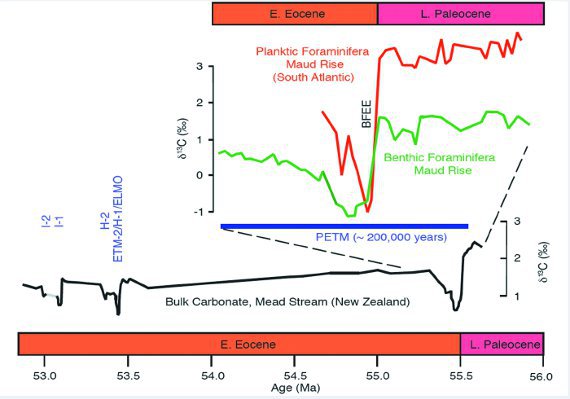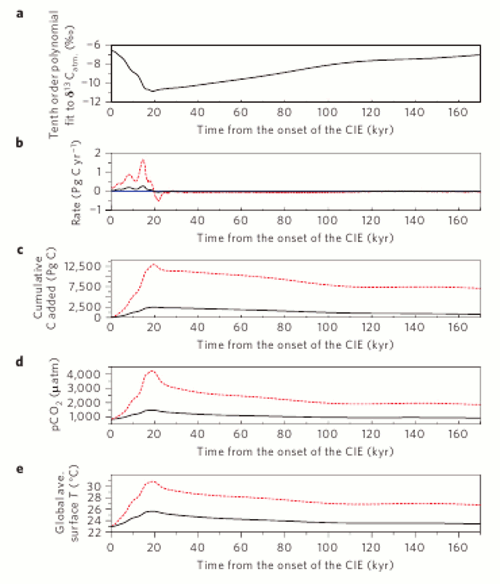CO2 Currently Rising Faster Than The PETM Extinction Event
Posted on 17 June 2011 by Rob Painting
The Paleocene-Eocene Thermal Maximum (PETM) was a period of natural global warming that took place almost 56 million years ago. It came at a time when the atmospheric concentration of CO2 was already higher than today, and global temperatures also much warmer. The PETM warming was a roughly 200,000-year long event where global temperatures rose by a further 6–8°C, and is thought to have been caused by a massive injection of CO2 into the atmosphere.
The PETM: A great carbon mystery
The existence of the PETM was first noticed when analysis of marine sediment cores, retrieved near Antarctica, revealed an abrupt change in the ratios of carbon-12 & carbon-13 isotopes. Land and marine plants discriminate against the heavier carbon-13 isotope when they are photosynthesizing, and because the sediments are depleted in that isotope, the carbon isotope ratios indicate that the CO2 was organic in origin. This abrupt PETM change is shown in the right-hand dip (@55.5 million years ago) in Figure 1 below:

Figure 1 PETM changes in the carbon isotopic composition of carbonate. The upper records are from Maud Rise in the southern Atlantic Ocean (Kennett and Stott 1991). The lower record is from the South Island, New Zealand (Nicolo 2007). BFEE = benthic foraminifera extinction events discussed in Nicolo (2007). Figure from (Dickens 2009)
A truly colossal amount of CO2 must have found its way into the atmosphere to create the observed fall in carbon-13 isotopes (called a negative carbon isotope excursion, or CIE, in the literature). Since the initial discovery, the CIE has been found in paleo records from around the world (the smaller CIE's in figure 1, show abrupt warming periods during the Eocene).
The PETM pulse of CO2 has been linked with acidification of the deep ocean and the extinction of tiny marine life called forams (foraminifera), and proved to be a difficult time for coral reefs. It was also a time of rapid change in land plants and animals, with a quick turnover of species and large migrations, although extinctions were limited.
No smoking gun
Hundreds of scientific papers have been published on the PETM, but because of the scarcity of paleo-data from this time, there has been no clear scientific agreement over what initiated this warming, or where all the CO2 came from.
A number of researchers have converged on methane clathrates in deep sea sediments as a possible culprit. Methane clathrates are molecules of methane frozen in a cage of water molecules, which are buried in sediments at the bottom of the ocean. If heated, or de-pressurized, they can quickly break down (oxidize) to CO2, either in the ocean or in the air. An attraction of methane hydrates as the source of CO2, is that methane is highly depleted of carbon-13, and therefore much less of it (than CO2) need be released to match the carbon isotopes shifts observed.
A number of other sources have also been examined too, such as volcanic activity disrupting organic sediments, and methane from permafrost on Antarctica (when it was much warmer), but the case is very much still open.
Abrupt is how long?
Examination of the sedimentary records shows an abrupt increase in CO2, followed by a rapid drawdown (perhaps a rise in silicate weathering), then a long tail of recovery as the PETM warming interval comes to an end. The deep sea cores are affected by the ocean acidification event, which dissolved carbonates in the sediment cores, so it has been difficult to tie down exactly how long this release of CO2 lasted. Previous estimates have been between 10,000–20,000 years.
A recently published study, Cui 2011, indicates that this splurge of CO2 was at the longer end of estimates - around 19,000 years. Cui and co-authors loooked at a sediment core that had been drilled at Spitsbergen, Norway, in a shallow coastal marine environment. Unlike other cores which can be highly condensed, the section from Spitsbergen, covering the initial PETM warming, is some 70 metres long, which provided a more detailed analysis.
Cui 2011 fed the data, collected from the sediment core, into a bare-bones climate model (GENIE), and then ran the model under two scenarios: one with organic carbon as the source, and one with methane, to find a best fit with the core data. They found that the maximum rates of CO2 release that match the PETM data are much lower than present rates observed today from fossil fuel burning.

Figure 2 Model results of the PETM carbon release rate and cumulative amount of carbon added versus time from the onset of the CIE (age model is from Charles 2011). a. carbon-13 atm that we used to force GENIE. b. model results of the PETM carbon release rate. c. Model results of the cumulative amount of carbon added. d. Model results of the PETM atmospheric pCO2. e. Model results of the PETM global average temperature (°C). The two best-?t simulations are shown in b–e: (1) Methane (CH4) simulation (black solid line); (2) Organic carbon simulation (red dotted line).
The authors find that the maximum PETM rate of emission for organic carbon as the source is equivalent to 6.2 billion tonnes of CO2 per year, and for methane as the source, 1.1 billion tonnes of CO2 per year. For comparison: 2010 human-carbon emissions were 30.6 billion tonnes. So if organic carbon was the source, current emissions are almost 5 times faster than the PETM, and if methane, current emissions are rising 27 times faster.
With the available data, it wasn't possible for the authors to determine which scenario was the more likely; however, many lines of research indicate that the massive pulse of CO2 was likely to have come from multiple sources. Therefore the above rates can be thought of as the most likely range of values.
Lessons from a previous global warming event
The PETM took place at a point in Earth's development when the climate was very different than today. It's important to stress that none of the preceding discussion implies that direct and complete comparisons can be made between the Earth climate of today, and the Earth climate of 56 million years ago. Much has changed since then, such as the layout of the continents, and the development of major mountain chains such at the Himalayas and Andes, the growth of major ice sheets, major cooling of the deep ocean and the poles, slight warming of the Sun, and changing Earth-Sun orbital characteristics, all of which greatly alter global circulations and therefore climate.
But now that we humans have embarked on a global warming experiment, there are some useful lessons from the past:
-
The rapid pulse of PETM CO2 followed by rapid warming (figure 2e) indicates high climate sensitivity.
-
CO2 does indeed appear to have a long atmospheric lifetime.
-
Ocean acidification (of the deep sea at least) can occur even under conditions of CO2 release much slower than today.
-
Present acidification of the ocean is far greater than the PETM, and is probably unprecedented in the last 65 million years.
Whether the plants and animals upon which humans depend can survive the present rapidly changing environment remains to be seen.
Recommended reading: Sks post - Wakening The Kraken































 Arguments
Arguments






























[DB] And your point is...?
The great Carbon influx into the atmosphere at the PTEM has been resolved. The eruption of the Northern Atlantic and High Arctic flood basalts at the time caused the largest insertion of greenhouse gases in earth's atmosphere in the last 290 million years. wpsokeland@yahoo.com
[PS] An email address is not a substitute for a reference to a published paper. Such a paper would be interesting but at first glance, such an explanation fails to explain the observed carbon isotope signature.